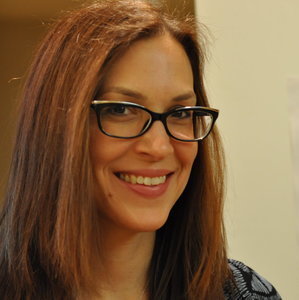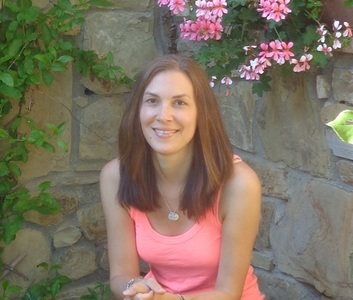It was actually in my uterus, on the cul de sac, on my right lower ligaments, on my appendix, on my bowel stretching across to the right side of my rib cage as well as in the muscle lining of my uterus (adenomyosis). No, endometriosis was most definitely not in my head as so many doctors proclaimed.
As long as I can remember I’ve been living with pain, and it all started back when I was 11 years old when I had my first menstrual cycle. I would get so sick with vomiting and cramping, and be in so much pain I wouldn’t be able to leave my bed or the washroom for the first two days of my period. I never understood why my friends wouldn’t get as sick as me. This was the first time I felt isolated. Every month I would miss at least two days of school–I’d miss out on birthdays, holidays, special occasions (I still do).
My mom used to console me and tell me that she used to have the exact same thing when she was young. When I would go to my doctor she would tell me that this is “normal, everyone woman goes through this” and “it’s nothing a little advil can’t help.”
I have endometriosis. Actually, I have endometriois and adenomyosis, chronic back and pelvic pain, vulvodynia, pelvic floor dsyfunction and I also suffer from depression and anxiety.
It wasn’t until I started becoming sexually active that I also noticed something else seemed off. Sex wasn’t fun… it sucked actually. It was painful and it felt like I was being stabbed. I would be nauseous afterwards and always have horrible back pain and cramping for days.
At this point, I was living in Vancouver. I went to a doctor out there and told him what was happening. His initial reaction was “cervical cancer” and after that was ruled out, he threw the word “endometriosis” at me. This was the first I time ever heard about “endometriosis” but I didn’t think much of it since he insisted it wasn’t a big deal and that the Mirena IUD would be my lifesaver. Well it wasn’t! Insertion was horribly painful and I cramped and bled for about two years straight. I have never felt the same since!
Finally, I was told that my body was rejecting it and had an emergency removal. I was told to just stay off of any type of birth control for a bit and see what happens, since I had been on continuous birth control from the age of 14. I was 25 at this point.
I started experiencing multiple ruptured cysts resulting in over three hospital stays in the course of four months, and I was told this time that surgery was the answer. I was trying to pursue my dreams in Vancouver, where the surgery was performed. The outcome was that he couldn’t find anything: in his words “ I had a beautiful looking uterus and everything looked fine.” I was in SEVERE pain yet there were NO answers! The pain just got worse and worse to the point where I could not work any longer. I was forced to give up my dreams and move back home to my parents’ house in Ontario and wait patiently for my turn to get into one of the best pain clinics in Toronto. Waiting patiently… my Endo-warriors know exactly how that feels.
In the meantime, my gyno referred me to a pelvic physiotherapist who I would see weekly to help with my vaginal spasms as well as internal manipulation to aid in my pelvic floor dysfunction. I was excited knowing that I would have some of the best doctors working on my case. Finally, some answers and some help! It was many months before I was admitted, where in an effort to end my pain I would try anything they suggested.
Blind nerve block injections were suggested as a treatment to numb my pelvic pain. Two to four needles were inserted into my pelvis on two different occasions. This was another let down. I now suffer from chronic pain in that area and constant hip locking as a result of these injections.
Yet another specialist suggested hormonal therapy (Visanne). The side effects from this resulted in a brief breast cancer scare (which did wonders for my anxiety). I now have permanent agonizing cysts in my breasts (fibrocystic breasts) and have an even deeper hatred for my own body.
It was right around this time that I hit an all time low. I was completely discouraged and hesitant to try any other kind of hormonal treatment that was being offered to me for fear of the side effects to my body. I was tired of being a guinea pig, and I felt very alone. I was so tired of hearing that it was “all in my head” and that maybe “I just needed to take some anti-depressants.”
It was right around this time last year that I reached out and found this amazing support group! And after having met other people who had such similar stories to mine, I started to see things in a different light. Maybe I wasn’t crazy? It was so comforting to know that I was not alone in my pain. I started hearing from more and more people who said it was very common to have a number of surgeries before endometriosis was found, and that sometimes the surgeons aren’t necessarily trained to spot endo in all of its forms. I went to the Endometriosis Symposium last year hosted by The Endometriosis Network Canada and educated myself even more. I left feeling empowered. There WAS something I could do…
With the encouragement and financial support of my parents, as well as some generous donations from friends through an online campaign, I finally sent all my health records to a world-renowned endometriosis specialist in Atlanta, Georgia. For two years I had been bouncing back and forth from doctor to doctor who all kept referring to that original surgery, saying that it obviously could not be endometriosis because none had been found. Well, a week after sending my records in, this endometriosis specialist called and after reviewing my past surgery report from Vancouver he confirmed that I most likely had endometriosis and that it was possible that he could improve my quality of life by 85%.
So, I took the trip out to Atlanta. During the surgery he found endometriosis in my cul de sac, on my right lower ligaments, on my appendix, on my bowel stretching across to the right side of my rib cage as well as in the muscle lining of my uterus (adenomyosis). He removed all the lesions as well as my appendix and he performed a presacral neurectomy, which involves snipping the main nerve to your uterus/bladder/bowel area. This is said to work for 75% of patients who no longer feel pain in that area. I, unfortunately, was not one of the lucky 75% of patients this works for. I was told to give my recovery at least six months. I was devastated when there was barely any improvement. Since the PSN didn’t work for me because of my adenomyosis, I will most likely need a hysterectomy in order to get the pain relief I was hoping for, which I am not ready for at the age of only 28. How bittersweet…I finally had an ANSWER, but still NO pain relief!
After constantly getting knocked down by this disease, I am standing up yet again. I am still in pain… I still fight to get through the days, today included. I want my voice to be heard. I am NOT crazy. The symptoms are NOT all in my HEAD. They are actually in my UTERUS!
In the spirit of The Endometriosis Network Canada’s #awishnoted campaign I’d like to share my three wishes.
I wish for more pain free days that I can spend laughing and making memories with my loving boyfriend, and with my incredibly supportive family that I am blessed to have (that includes my endo family too) and with my friends who thanks to this disease I don’t get to see as often anymore.
My second wish is for more funding for endometriosis research right here in Canada.
And last but definitely not least, I wish for the next generation to be educated about endometriosis in health classes at school. Knowledge is power, and together our voices will be heard!
To read more about my journey with endometriosis and adenomyosis, follow my blog at http://uterusinterrupted.blogspot.ca/.









